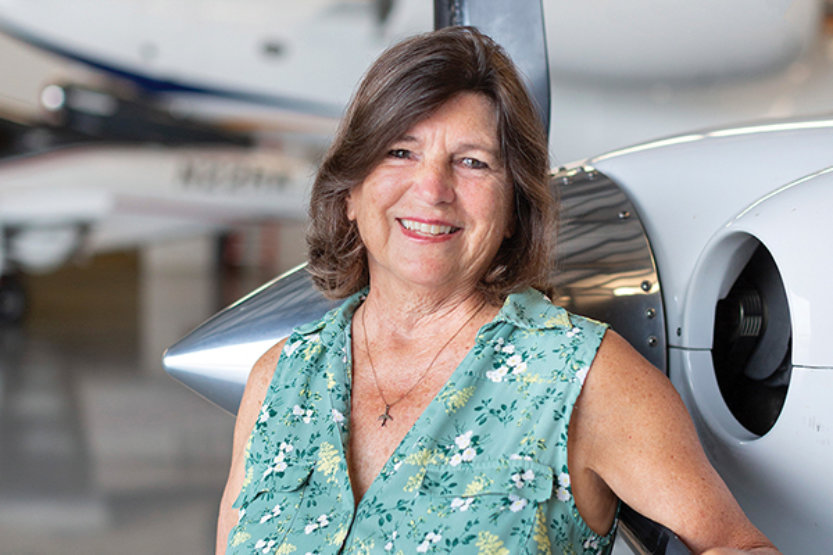Alumni Interview: Lynn Rippelmeyer
 Capt. Lynn Rippelmeyer, ’72 LAS, retired as a captain with Continental in 2014. She founded ROSE (Roatan Support Effort) to fly aid into Honduras. She delivers seminars on her experiences, and her book, Life Takes Wings: The Cabin to Cockpit Journey of the First Female 747 Pilot, is forthcoming. (Image by Jenn Duncan)
Capt. Lynn Rippelmeyer, ’72 LAS, retired as a captain with Continental in 2014. She founded ROSE (Roatan Support Effort) to fly aid into Honduras. She delivers seminars on her experiences, and her book, Life Takes Wings: The Cabin to Cockpit Journey of the First Female 747 Pilot, is forthcoming. (Image by Jenn Duncan) What a time to join aviation! The 747 had just been introduced in 1972, and TWA started around-the-world service. A sorority sister persuaded me to join her in New York City in her new career as a stewardess. The 747s tended to be crewed by the most experienced pilots, and as one of the youngest, newest flight attendants, I was assigned to an undesirable job—to serve the cockpit. Sexual harassment wasn’t on anyone’s radar then, and the pilots considered it “entertainment” to be generally crude, rude and socially unacceptable.
I learned to ask questions—what are all the switches and dials for, what is your job like? When you got them talking about themselves and airplanes, you could have an intelligent conversation. My initially feigned interest quickly became absolutely real.
The amazing view from the cockpit reminded me of my childhood in Valmeyer, an Illinois farming community on the Mississippi. I’d had a horse from the time I was 12. I would ride to the top of the limestone bluffs for a view of the valley. It looked like a patchwork quilt of green and gold stitched together by rivers and railroads. There, I would dream of flying.
The idea of becoming a pilot didn’t occur to me then. Growing up in the 1950s and ’60s, there were societal norms and gender rules that you just accepted. But there also were subtle hints that this didn’t have to be; Annie Oakley and Dale Evans rode horses just as well as men. Raised to believe teaching was my only career option, I majored in education. Yet, as I quizzed those pilots—and later studied a pilot’s training manual one of them gave to me to “answer questions without bothering people”—I realized they weren’t doing anything I couldn’t do.
Thanks to the Equal Employment Opportunity Commission, American and Frontier were the first to hire women pilots. I took lessons to get my private and commercial licenses, and then I started flying charters while still a flight attendant. On a trip to visit my sister at Southern Illinois University, I came across a kiosk in the St. Louis airport for Air Illinois. Thinking I’d rather fly than drive, I asked if I could ride along in professional courtesy. I learned that to ride for free, I’d have to interview for a job—and they had enough flight attendants. What they needed were pilots. I said, half-jokingly, “Well, then, I’ll interview for that.”
Just doing my job, I found myself part of the first all-women crew for a scheduled airline—although, we were told to keep the door closed and make no announcements.
On arrival, the owner—a big guy with a military haircut holding a coffee mug proudly branded Male Chauvinist Pig—greeted me with, “So, you think you want to be a pilot?” Joke’s over, I thought. Two weeks later, I got the call. “We’ve already hired a woman as a captain. You’re going to be a first officer. Can you be here in two weeks?”
Captain Emilie Jones and I initially weren’t allowed to fly together—couldn’t be a crew without a man—until one rainy day when I had to rush to the airport because no man was available. Just doing my job, I found myself part of the first all-women crew for a scheduled airline—although, we were told to keep the door closed and make no announcements.
Flying the Twin Otter at Air Illinois gave me the experience I needed to apply to be a pilot at TWA. I became the first person to transition from flight attendant to pilot when I was hired as a 727 flight engineer, one of the first three women hired there.
In 1980 at Seaboard World Airlines, I became the first woman to pilot a 747. Four years later at People Express, I became the first woman to fly a transoceanic jumbo jet. I landed at London’s Heathrow Airport and was greeted by the press. I was even named a U.K. Woman of the Year for it.
I ultimately relocated to the Houston area to raise a family as a single mom. I selected the day run to Toncontín International Airport in Tegucigalpa because I could drop my kids off at school, fly to and back from Honduras, and pick up my kids on the way home. When I asked for that route, I had no idea that the airport is one of the world’s most dangerous to land an aircraft. What may have seemed like nerves of steel was more just a woman’s heart, making the choices a working mother has to.

